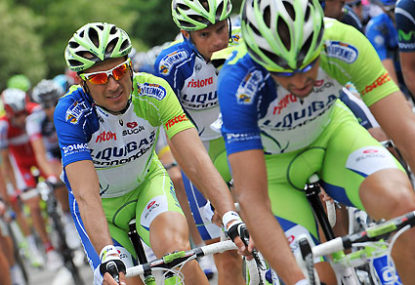'I've just won a stage of the Tour de France, mate!': Hindley grabs yellow jersey as Aussie blows Tour apart
Australia's Jai Hindley has said he is "lost for words" after a shock stage victory at the Tour de France earned him the leader's…

This coming Friday is stage seven. My roughie for one of the best stages of the Giro.
Only three stages in we can clearly see that this bike race is like no other: all the transfers, the ferries, the presentations, podiums, pink confetti and countless coffees.
This grand tour resembles more of a rolling mardi gras of festivities than a bike race.
The excitement and exuberance the Giro instils in those who follow it comes directly from the legs and minds of the riders who create it.
This Giro is big. It’s hard, and I’m exhausted already.
We’ve had a big bunch sprint, a teams time trial and a medium mountains stage already. We’ve had everyone from Cavendish to Cadel throwing their hat in the ring. After just three days!
But I’m earmarking stage seven.
Stage seven of this year’s Giro is a saw tooth profile guaranteed to leave riders with sore legs and sore heads.
What it demands of riders physically is possibly only surpassed by the demands it will place on riders mentally.
Back in March Michele Aquarone, the organiser of the Giro and Tirreno Adriatico, took riders over a tortuous series of short and steep climbs through Italy’s Abruzzo region during the stage race that serves a popular pre Giro hit out.
Such was the severity of the course riders took to every social media medium available to complain about the sheer ridiculousness of the stage.
Even the hardest of the hard, Mr Cancellara, proclaimed:
“I have just to say today’s stage has nothing to do with bike racing. All the steep climbs we done you find in the area. I call it #sadomaso”
Aquarone himself took to twitter to apologise for what he put riders through;
“Many of you enjoyed it, but it was too much. We lost the right Balance. #Tirreno”
But guess what? We’re back!
Stage seven will polarise the peloton. It’s great for the breakaway riders and opportunists. But it’s not so great for GC riders, or anyone, who wants a stress free day.
The 177 kilometre stage begins with some small climbs from the gun.
Most riders will be thinking, perfect, a chance for the break of the day to go.
Normally it goes like this: flag drops, people attack, the break goes. It takes a while until the right mix of riders is found such that most teams are happy, but eventually the break sticks. This is what we call the first hour of racing.
Once the break is established the GC leader and his team have the unspoken authority to call, and usually do call, for the ‘pisso’ break.
Not normally seen on regular TV coverage this is where the peloton virtually stops and everyone stops to offload their pre-race espresso doppio and grab some drinks to see them through to the feed station.
Out in the breakaway when you see your time gap go from 30 seconds to four minutes, you know you are going to be out front all day.
Then the GC team rides the front, keeps the gap in check and towards the finish the sprinters teams ramp it up and it all comes together on script with a few kilometres to go.
Dull, dry and devoid of any surprise.
But stage seven is oh so different.
Up, down, left, right.
Narrow roads, steep rises, dropped chains and frantic mechanicals.
Throw in rain, throw in the battle to stay at the front, throw in opportunists trying to sneak GMP points or a stage win.
Throw in Samu Sanchez, Nibali or Cadel Evans himself attempting to give Wiggins a lesson in descending as we run in towards the finish.
Throw in Orica-Green EDGE trying to lug Matt Goss over the final rollers to blast home in the sprint.
Throw it all in and we get one hell of a stage, all augmented by one hell of a finish.
With an 8.5% 1.3Km climb followed by a technical descent that will leave riders within 5km of the days end, we will see attacks.
Following such a brutal repetition of steep climbs earlier in the day it will great to see who can try and catch their fellow GC contenders napping as they hit the steeper 14% grades at the bottom of the San Silvestre climb.
GC riders such as Wiggins truly loathe a stage like this. He wants predictability. He wants control.
Thus there is little to gain for those wishing to challenge Wiggins by allowing the ‘SKYbots’ to write their own narrative.
The only dampener on the excitement exuding from this stage is the 55 kilometre time trial riders will face the following day. Riders generally want little more than an easy trundle the day before such a crucial stage.
Being realistic, however, those riders who see themselves losing chunks of time to Wiggins need to take it to him. They need to pick their battles. This is a battle they can win.
Wiggins has everything to lose and nothing to gain on stage seven.
We do not want to see the Giro decided solely on the bad luck that one rider suffers.
We do, however, want to see other riders maximising their chances by throwing everything they’ve got at him.
In order to win the race, you have to risk losing it.
Perhaps we will see a crash on a descent. Perhaps there will be collaboration among thieves.
Perhaps nothing will happen at all.
But missing the defining moment of the giro?
I wouldn’t risk it.